26 Penguin Facts to Make You Waddle With Joy! [2025]
Do you know what penguins like to eat for lunch?

Ice-burgers!
I know, I know, I’m pretty funny. But don’t worry; the rest of this article is full of TRUE penguin facts. 🙂
These flightless birds are incredibly interesting, and it’s no wonder they are so popular all over the globe!
There is a lot of remarkable penguin knowledge that we are going to share today!
26 FUN facts about penguins!
Fact #1: No one agrees on how many penguin species exist!

Determining the number of penguin species on the planet seems pretty straight forward, but nobody can seem to agree.
All I can tell you is that there are somewhere between 17-21 living species of penguin, depending on which scientific authority you subscribe too.
First, here are the 16 penguin species that EVERYONE seems to acknowledge:
King, Emperor, Adélie, Chinstrap, Gentoo, Little, Australian Little, Magellanic, Humboldt, Galapagos, African, Yellow-eyed, Fiordland, Snares, Erect-crested, & Macaroni.
Now here is where the controversy arises:
Royal Penguin: Some people consider them a subspecies of the Macaroni penguin because these two sometimes interbreed in the wild.
White-flippered Penguin: Most scientists consider them a subspecies or color morph of the Little Penguin. There was some DNA analysis done that shows differences between the two penguins, but whether it’s enough to classify them as individual species is still up for debate.
Rockhopper Penguins: The Rockhoppers are just a mess. Three closely related subspecies are either grouped as one or recognized as three unique species; Southern, Eastern, & Northern.
Regardless, I have this awesome penguin poster hanging in my house, which recognizes 17 unique species. I love that it shows where each one lives!

Fact #2: Penguins and Polar Bears are NOT Besties.
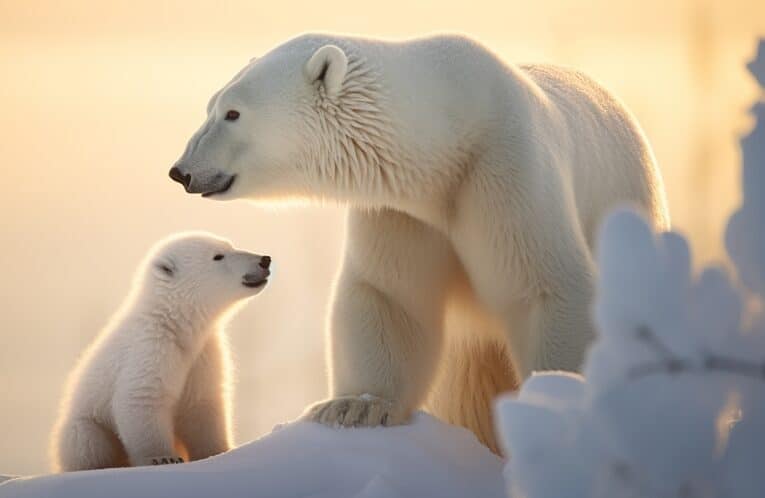
It’s NOT because Polar Bears eat penguins (although they probably would).
The truth is, they’ve never met!
Polar Bears ONLY live in the Northern Hemisphere. They make their homes in countries around the Arctic Circle such as Canada, the United States (Alaska), Russia, Greenland, and Norway.
However, penguins do NOT live in the Northern Hemisphere! All species of penguins live in the Southern Hemisphere!
(Okay, I lied a little bit. The Galapagos Penguin lives on the Galapagos Islands in Ecuador. Technically this is the Northern Hemisphere, but not by much!)
Polar Bears and penguins are a world apart from each other.
I know this fact may blow your mind.
And you may be sad to learn that the cute Coca-Cola commercials with Polar Bears and penguins meeting each other are outrageously inaccurate. To be honest, when this commercial aired initially, I was so disgusted that I permanently switched to Pepsi. 🙂

It’s incredible how many kid shows get this basic fact wrong and think Polar Bears and penguins live together!
Since humans are a curious bunch, penguins have been brought to many zoos and aquariums in the Northern Hemisphere so we can see and study them. There are just no “wild” populations in the north.
Fact #3: Penguins like the beach!
Well, some of them do!
The Galapagos Penguin lives in tropical climates on an island near the equator! And the African Penguin lives on the warm coasts of South Africa.
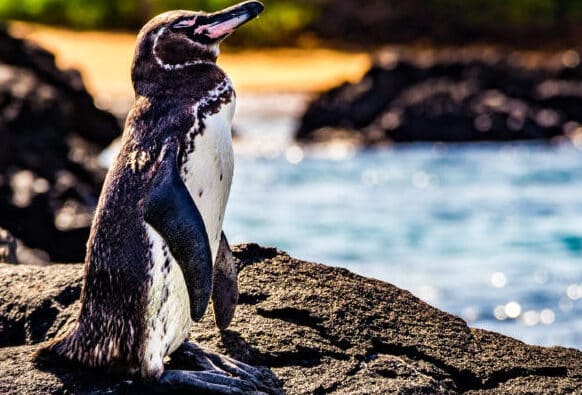
It’s a myth that Penguins only live in the cold weather of the Antarctic. You can find them in South Africa, Australia, New Zealand, and along the entire west coast of South America.

In fact, only SEVEN penguin species LIVE in Antarctica.
Fact #4: Penguins can swim REALLY fast.
Although they resemble little bowling pins, penguins have the perfect body for swimming!
Rather than wings to fly, penguins have paddle-like flippers with short little feathers. These adaptations help them fly through the water!
Check out how fast these African Penguins can swim and hunt!

Furthermore, penguins have solid bones, rather than air-filled ones like birds that fly. These dense bones offset buoyancy to help them dive deeply underwater!
Even though they are awkward on land, once in the water, penguins are extremely fast! For example, the Gentoo Penguin can swim up to 22 mph! To put it into perspective, Michael Phelps can only swim around 5-6 mph!
Fact #5: Penguins are deadly, efficient hunters.
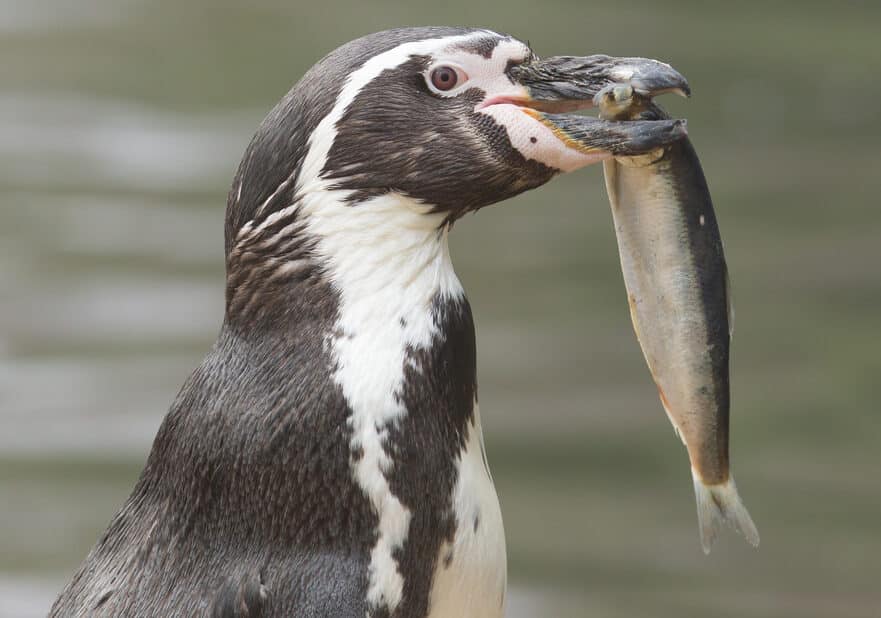
Trust me; you don’t want to be a fish that is being hunted by a penguin.
A recent study followed eleven Adélie Penguins for fourteen hours. Each of the penguins had a camera attached so the scientists could observe their behavior.
In more than fourteen hours of filming, not once did a penguin fail to capture its prey!
No wonder they spend 75% of their lives in the water!
Fact #6: Penguins sneeze a lot.
There is one big downfall to spending 75% of your life in the water:
Saltwater!
Luckily, penguins have adapted well to handle it!
Penguins ingest a lot of saltwater while hunting! To avoid getting sick and dehydrated from the salt, penguins have a special gland behind their eye (supraorbital gland), which filters out the saltwater from their bloodstream.
Penguins will then excrete the salt either through their beaks or by sneezing!
This is commonly known as the “salt sneeze” or “salt shake” and can be seen in the video below!

Fact #7: Penguin eyes are amazing!
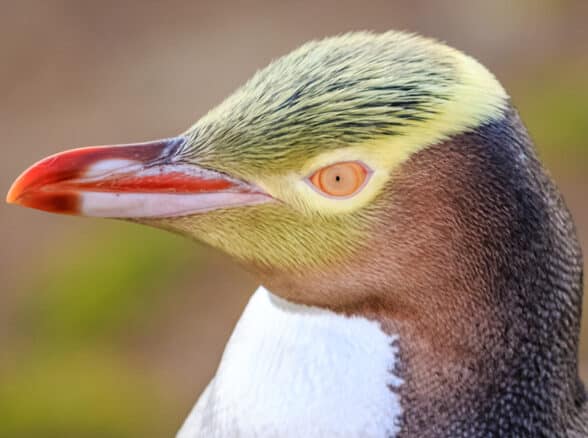
Because penguins are visual hunters and spend lots of time both in the water and on land, their eyes have adapted to see in both environments.
Like all birds, penguins have a translucent third eyelid called a nictitating membrane. When swimming, this membrane covers their eyes, protecting them from injury while underwater. It’s sort of like having built-in swim goggles!

In this picture, you can see the nictitating membrane covering the Bald Eagle’s eye.
-
RELATED: 18 FUN Facts About Bald Eagles!
Penguins have also evolved strong eye muscles, which can change the shape of their eye lens to help have sharper vision underwater. In addition, they developed a flattened cornea to reflect less light.
Penguin eyes are no small evolutionary feat! Just think how poorly your eyes perform while swimming underwater. Without goggles, you wouldn’t see anything! But penguins can go smoothly from land to sea and have no problems seeing.
Fact #8: They are birds!
Yes, I know you probably already knew this fact.
However, many people think they are mammals or fish!
“Where are the feathers on these so-called birds? Why can’t they fly?” they might ask. “Turtles lay eggs, have beaks, and can’t fly too. Are they a turtle!?”
Nope. Not a turtle either.

Penguins are warm-blooded, have both beaks and feathers, and they lay eggs. And their skeletal structure is definitely avian, too. There is no doubt they are birds.
The reason their feathers look like fur is due to how densely packed they are. For example, Emperor Penguins have the highest feather density of any bird species, averaging 100 feathers per 6.5 square centimeters.
Also, they exude an oil that keeps them waterproof and, more importantly, traps air to insulate them from the cold temperatures.
Fact #9: They have “Catastrophic Molts”!
Just like other birds, they will molt, which means they lose their feathers to make way for new growth.
However, unlike other birds, they don’t gradually lose feathers throughout the year. Instead, penguins go through what is called a Catastrophic Molt!
Sounds intense, right!?
It kind of is! For 2 to 3 weeks, penguins will lose almost all their feathers at once. During this time, the penguin has to remain land-bound because they will no longer be waterproof.
Yikes. Catastrophic is definitely the right word to describe this:

Did a pillow explode?!
Fact #10: They are not very committed to their mates.
Most species of penguins breed in large colonies that include thousands of birds! As you can imagine, it can get a little congested. For example, Chinstrap Penguins hold the record for the largest colony size at 2 MILLION birds.

Because of these massive colony sizes, most penguins don’t mate for life! Roughly half of all penguins swap mates every year!
Why?
When the penguins return to the breeding colony, there is a good chance they never find their mate! It’s just too crowded!
If they happen to meet up with their previous partner, then great! If the male is not there when the female arrives, she goes to her last nesting site and takes up with another male.
Fact #11: Emperor Penguins make me feel lazy.
Emperor Penguins have one of the most fascinating and rigorous breeding rituals in the entire animal kingdom! It is captured wonderfully in the wildly popular documentary called “March of the Penguins,” narrated by Morgan Freeman. (If you haven’t watched this movie, you need to!)

Every March in Antarctica, both male and female Emperor Penguins leave the ocean to march inland to their breeding grounds, which are between 30-75 miles away!
Once the penguins have mated and a female lays an egg, she transfers it to the male. Then she leaves and makes her way back to the ocean to feed herself for two months.
While the female is gone, the male is responsible for caring for and incubating the egg on top of his feet during the cold, stormy winter.

Some males die due to starvation during this challenging period!
The female returns after a few months to take her turn caring for the chick. Once she is back, the male makes his way back to the ocean to eat.
After a few weeks of feeding, the male returns. Then, both parents take turns feeding the chick regurgitated food and keeping their baby warm and alive until it’s large enough to take care of itself.
Emperor Penguins are the only animals to breed during the Antarctic winter, which features some of the worst weather conditions on earth.
Fact #12: Females kidnap other penguins’ chicks!
Female Emperor Penguins are known to kidnap chicks from each other if they lose their baby. It’s not uncommon for fights to break out as chick-less penguins try to steal from another penguin family.

Unfortunately for the baby chicks, if they are kidnapped, it isn’t a long-term solution.
The kidnapping typically only lasts several days to a week, and then usually, the chick is abandoned and left to die through starvation or cold.
Sorry, this section was incredibly sad. 🙁
Fact #13: Penguins weren’t impressive to early explorers.
One of the first documented sightings of a penguin came on a pretty famous voyage!
In 1520, Ferdinand Magellan was on his first circumnavigation of the globe!
While near Argentina, a member of his ship wrote about seeing a penguin.
However, at the time he described them as “strange geese!”

Fact #14: “Some penguins are gay. Get over it.”
The following banner hangs over the penguin exhibit in the London Zoo during Gay Pride Week!

Most of the time, when animals form bonds, it is for mating and reproduction. However, penguins don’t always follow that trend.
First observed over a century ago, homosexual penguins are a somewhat common occurrence to witness. In fact, some homosexual penguin couples in zoos have successfully raised adopted chicks!
Love knows no boundaries!
Fact #15: Penguins are the “National Animal” of…
Antarctica!
Wow! What an honor! Go penguins!
Not to diminish this award, but they don’t have much competition. The only other animals that live in Antarctica are a few whales and seals.
But hey, it’s still pretty awesome!
Fact #16: They come in all shapes and sizes!
The largest species of penguin is the Emperor Penguin. Both males and females stand up to 48 inches tall (122 cm)!
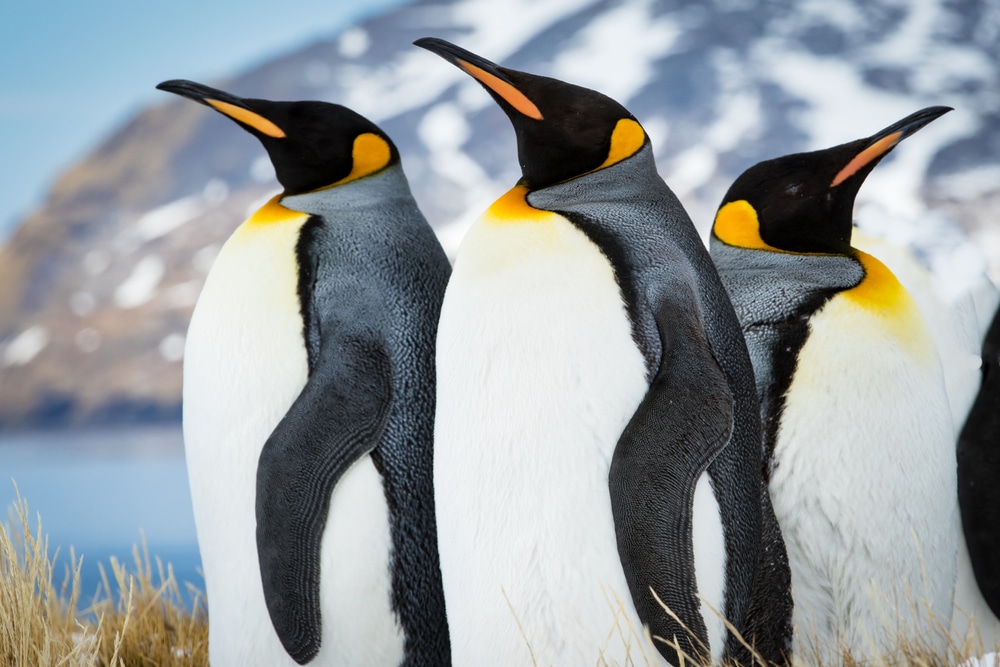
The smallest member of the penguin family is the rather uncreatively named Little Penguin. It stands only 13 inches tall (33 cm) and is seen most often in Australia and New Zealand. To put this in perspective, it’s not long before an Emperor chick is larger than a full-grown Little Penguin!

Interestingly, it seems that no one likes the name Little Penguin. Australians, unhappy with the silly name, have dubbed it the Fairy Penguin, due to its diminutive stature. In New Zealand, they like to call it the Little Blue Penguin, or simply the Blue Penguin.
Fact #17: Penguins are tasty for predators, but disgusting for humans.
As we mentioned earlier, penguins are efficient hunters that prey on large numbers of fish and krill.
However, many predators like to eat penguins.
While swimming in the ocean, penguins can be hunted by several animals, including Leopard Seals, Weddell Seals, Orcas, and sharks.

As they are waddling on land, penguins are targets for some birds, including the Skua and Australian Sea Eagle. And depending on where they live, certain penguin species and their eggs are vulnerable to rats, foxes, snakes, and cats.
I found it interesting that penguins probably taste disgusting to humans. No person has eaten one for a long time since they are a protected species, but there are a few accounts of early Antarctica explorers trying these birds.
Supposedly, the penguins were not very good. A Belgian seaman gave this description in 1898:
“If it’s possible to imagine a piece of beef, odiferous codfish, and a canvas-backed duck roasted together in a pot, with blood and cod-liver oil for sauce, the illustration would be complete.”
I also read that any animal that only eats fish as its primary food source is not particularly tasty to eat.
Fact #18: Their tuxedos are not just to look good.
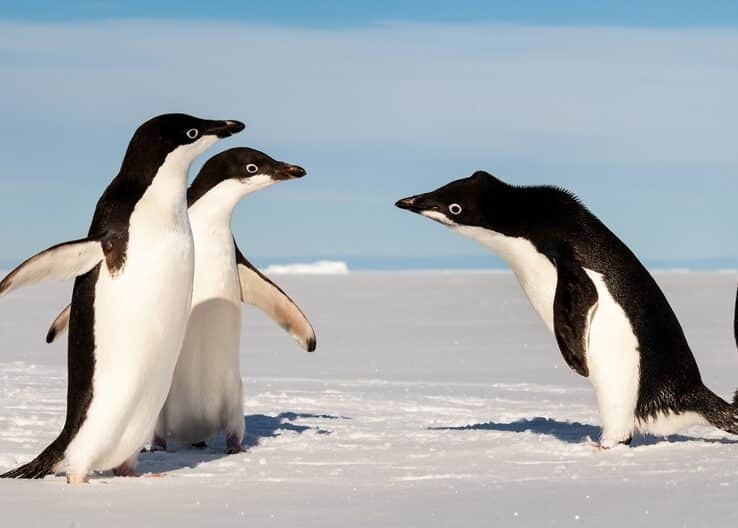
The black and white coloring of a penguin reminds most people that they are always wearing a tuxedo.
But their formal coloration is actually an adaptation. It provides some pretty convincing camouflage to help avoid being eaten by a shark, seal, or whale!
Imagine you are a predator hunting a penguin in the ocean. If you are swimming above the penguins looking down, the black on their backs looks like the color of deep water. The penguins would be hard to see!
Now imagine you are that same predator, but you are swimming underneath the penguins and you look up. The white on their bellies blends in with the light coming from the surface!
Many other animals have adapted this same coloration, including orcas.
Fact #19: They have been around a LONG time.
The oldest penguin fossils ever discovered were from 60 million years ago! They were found in the shallow seas off New Zealand’s east coast and are officially called the Waimanu penguin.
During this period, New Zealand had already separated from Australia and Antarctica. It was a chunk of land that was much closer to the South Pole.
Researchers have indicated that its long bill and condensed wing bones show that it would be quite at home eating and swimming in today’s Antarctica!
This information indicates that an ancestor of the birds we see today survived the mass extinction of the dinosaurs!
Fact #20: They have better “hair” than 80’s rock bands!
Some species of penguins have some pretty impressive “hairstyles”!
First, check out the signature look of the Macaroni Penguin.

Even though Emperor Penguins get a lot of popularity, Macaroni Penguins are the most common species, with an estimated 18 million living on the planet.
However, the Southern Rockhopper Penguin goes it one better with their gel-spiked crewcut designed to impress the ladies. To attract mates, rockhopper penguins literally shake their heads around to make their yellow crests twirl, just like a headbanging rock star. (Seriously!)

I think the Fiordland Penguin pulls it off best with simple, sleek yellow hair running alongside their heads. I don’t think I’d want to run across one in a dark alley!

Fact #21: Not all penguins are black AND white.
As you know, most penguins are a combination of black and white, typically having black backs with white fronts. But once in a while, you will find a bird that doesn’t look like your typical penguin.
It is incredibly rare, but it is possible to see a penguin that is all BLACK!

This Emperor Penguin has a mutation called melanism that causes all of its feathers to be entirely black!
Not to be outdone, it’s also possible to see a WHITE penguin!

This “blond” Chinstrap Penguin is leucistic. It’s not considered albino because there is a bit of patterning on its back. Regardless, it’s an incredibly rare sighting. Unfortunately, this mutation puts the penguin more at-risk to predators because it stands out among the crowd.
Fact #22: They can hold their breath for a LONG time.
Penguins primarily eat fish and krill in the ocean. In order to catch their prey, some penguin species have to dive REALLY deep, which means they have to hold their breath for a long time, up to 20 minutes for some!
Here are a few of the more impressive species:
Emperor Penguin: This species is the diving champion. The longest recorded dive lasted 22 minutes! They regularly dive between 100-200m (328-656 feet), but the deepest on record is 565m (1853 feet)!
King Penguin: They usually dive down to around 100m (328 feet), but the deepest was recorded at 500m (1640 feet). And they can hold their breath for twenty minutes!
Gentoo Penguin: They can hold their breath for up to seven minutes and regularly dive as low as 200m (656 feet).
Fact #23: Forget the diamond ring. Penguins want a rock!

To help attract a mate, male Gentoo Penguins give pebbles to females.
She will then inspect the offer. If it’s accepted, then she takes the rock and adds it to her nest.
Adélie Penguins also exhibit the same behavior towards pebbles, and they treat these rocks as prized possessions. If a female Adélie accepts a stone, then it could mean they mate for life!
This obsession over rocks sounds very familiar. Where have I heard about another species that offers a diamond to their potential mates hoping they say “Yes” to being mates for life?
Fact #24: Penguins slide on their bellies.
Penguins are perfectly adapted to swimming in the ocean. But they have not evolved to walk gracefully on land, which is one reason their walk is called a “waddle.”
To help get around while not at sea, many penguin species will slide on their bellies over the ice and snow. Not only does it use less energy than walking, but most of the time, it provides faster transportation.

This act is known as “tobogganing.”
Fact #25: Penguins use physics to launch themselves.
Penguins can propel themselves from the sea onto land at breakneck speed.
There is some fascinating science behind how this happens!

After completing a long dive, penguins will head to the surface before exiting the water. While treading, the penguins trap tiny bubbles of air inside their dense feathers.
As they approach the surface to exit the water, the penguins can release these microbubbles at the perfect time. When this happens, the air creates a lubricating coat that reduces friction which helps the penguin torpedo out of the water!
Fact #26: They don’t make traditional bird nests.
Here is a picture of a typical bird nest.

Unfortunately, something this comfy and cozy is not feasible for penguins. Most of the places they live in are devoid of much plant life.
So, penguins make do with what they have! Many species create nests for their eggs out of rocks, pebbles, and loose feathers.

Emperor and King Penguins don’t make a nest at all! Once the egg is laid, it’s transferred to the top of their feet and is covered by a featherless fold of skin that keeps the egg warm!
Final Thoughts
People who know me are very aware that penguins are my favorite animal!
(Bonus Fun fact: I have dressed up as a penguin for more Halloweens than I can count!)

Penguins may not be your favorite animal, but next time April 25th rolls around (World Penguin Day), you’ll have some pretty interesting facts to share!


